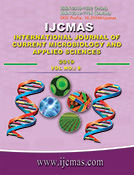Optimization of Carbon and Nitrogen Source for the Production of an Antimicrobial Biopeptide from Bacillus firmicutes against Food Borne Pathogens
S. Uday1 and M.P. Prasad2*
1Ramaiah College of Arts, Science and Commerce, Bangalore, India 2Department of Microbiology/Biotechnology, Sangene Biotech, Bangalore-560071, India
*Corresponding author
Abstract:
The presence and growth of microorganisms in foods is harmful to human and animal health. The consumption of those foods results in food borne diseases. Thus the major concern is the control of microorganisms to increase the shelf life and prevent harmful microorganisms. Bioactive peptides are known for their ability to inhibit protein-protein interactions due to their small size and speciï¬city. Nature remains the largest source of bioactive peptides since plants, animals, fungi, microbes and their products contain various proteins in them. Currently food preservation by the antimicrobial activity of biopeptides against microorganism growth has been studied. The present study is aimed at optimization of the chemical constituents like carbon and nitrogen sources in the production of the biopeptide from the isolated bacteria identified as Bacillus firmicutes based on 16S rRNA sequencing and sequence analysis and its activity against the isolated food pathogens like E.coli, S aureus, Pseudomonas aeruginosa, Shigella sps, Salmonella sps and L. monocytogenes. Media optimization for the isolate was conducted by varying the carbon (Fructose, Sucrose, Glucose, Maltose, Starch) and nitrogen (Urea, Ammonium nitrate, Ammonium sulphate, Ammonium dihydrogen phosphate, Sodium nitrate) sources. The Maximum antimicrobial activity was observed with 2.0% of glucose media against E. coli. Maltose in the medium showed the least inhibitory activity against all the food borne pathogens. The least activity was seen with 0.5% of the concentration of the carbon sources. The maximum zone of inhibition appeared at 2.0% of ammonium nitrate against E. coli by the isolate. The least antimicrobial activity was seen against L. monocytogenes in both the carbon and nitrogen sources used in the media by the isolate. No antimicrobial activity was observed with 0.5% of the nitrogen source in most of the cases.
Keywords: Bacillus firmicutes, Biopeptide/Bacteriocin, Antimicrobial activity, Food borne pathogens, Optimization
Download this article as 
How to cite this article:
Uday, S. and Prasad, M.P. 2019. Optimization of Carbon and Nitrogen Source for the Production of an Antimicrobial Biopeptide from
Bacillus firmicutes against Food Borne Pathogens.
Int.J.Curr.Microbiol.App.Sci. 8(1): 3202-3211. doi:
https://doi.org/10.20546/ijcmas.2019.801.342
 Citations
Citations



 National Academy of Agricultural Sciences (NAAS)
National Academy of Agricultural Sciences (NAAS)





